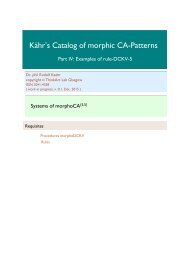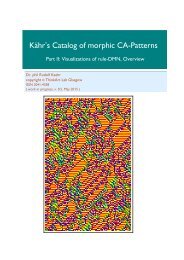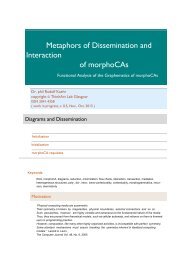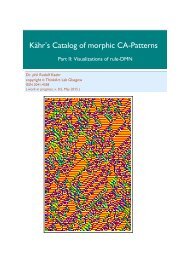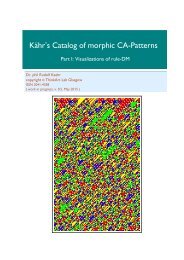Towards a new Paradigm of Board Games
"There is no reason that forces the game industry to restrict itself on a paradigm of games that is repetitive, addictive, regressive and is denying the right of the user to develop his/hers intellectual capabilities of creativity. It is a strategic decision of the game industry to stupidify its costumers." ThinkArt Lab To introduce the paradigm of morphic (board) games, I start with two simple questions. Why are classical games producing regressive addiction and boredom? What are the differences between classical and morphic games? My first answers to the questions might be summarized as follows: Classical games are based on the perceptive acts of identification and separation of the elements of the game by the rules of the game. Morphic Games are involved into differentiations and structurations of interactive and reflectional patterns (morphograms) in complex constellations. For a more conceptual answer of the two questions I connect the proposed new kind of games to the theory and practice of morphogrammatics. What do I understand by morphogrammatics? Morphogrammaitics is a pre-semiotic theory of inscription. It is studying and formalizing the 'deep-structure' of semiotics. Mathematically, morphograms, as the fundamential patterns of morphogrammatics, are representations of Stirling numbers of the second kind. Formal semiotics consists of an sign repertoire and rules of maipulating its signs. This is established by a strict difference of operators and oprands (signs). In contrast, morphograms are playing a double role: they are involved in a chiastic interplay of patterns (operands) and rules (operators). This is in decisive conterast to identity-based semiotic systems that are based on atomic signs. Strings of signs are based on a set of signs with cardinality m and its potentiation (n): m^n. Hence for m=4 and n=4, there are exactly 4^4 = 256 different semiotic strings possible. But on a morphogrammatical level there are just exactly Sn(4,4) = 1+6+7+1=15 morphograms for m=n=4 possible. In this sense, those 15 morphograms are presenting the 'deep-structure' of the set of semiotic strings of length 4.
"There is no reason that forces the game industry to restrict itself on a paradigm of games that is repetitive, addictive, regressive and is denying the right of the user to develop his/hers intellectual capabilities of creativity.
It is a strategic decision of the game industry to stupidify its costumers." ThinkArt Lab
To introduce the paradigm of morphic (board) games, I start with two simple questions.
Why are classical games producing regressive addiction and boredom?
What are the differences between classical and morphic games?
My first answers to the questions might be summarized as follows:
Classical games are based on the perceptive acts of identification and separation of the elements of the game by the rules of the game.
Morphic Games are involved into differentiations and structurations of interactive and reflectional patterns (morphograms) in complex constellations.
For a more conceptual answer of the two questions I connect the proposed new kind of games to the theory and practice of morphogrammatics.
What do I understand by morphogrammatics?
Morphogrammaitics is a pre-semiotic theory of inscription. It is studying and formalizing the 'deep-structure' of semiotics.
Mathematically, morphograms, as the fundamential patterns of morphogrammatics, are representations of Stirling numbers of the second kind.
Formal semiotics consists of an sign repertoire and rules of maipulating its signs. This is established by a strict difference of operators and oprands (signs).
In contrast, morphograms are playing a double role: they are involved in a chiastic interplay of patterns (operands) and rules (operators).
This is in decisive conterast to identity-based semiotic systems that are based on atomic signs. Strings of signs are based on a set of signs with cardinality m and its potentiation (n): m^n. Hence for m=4 and n=4, there are exactly 4^4 = 256 different semiotic strings possible.
But on a morphogrammatical level there are just exactly Sn(4,4) = 1+6+7+1=15 morphograms for m=n=4 possible. In this sense, those 15 morphograms are presenting the 'deep-structure' of the set of semiotic strings of length 4.
You also want an ePaper? Increase the reach of your titles
YUMPU automatically turns print PDFs into web optimized ePapers that Google loves.
Morpho<strong>Board</strong><strong>Games</strong>.nb 13<br />
n u z l n l n v n w v<br />
v w u w m n m z z z m<br />
m w z s v z m n s e e<br />
w l e l u e l u v z m<br />
w s v l u v z m u w l<br />
m n w n v z n s u v z<br />
n l e w l v m n e w v<br />
v e m w s l l w v l m<br />
Decompositions <strong>of</strong> board one<br />
One possible solution <strong>of</strong> the <strong>Board</strong> is given by the following 18 steps <strong>of</strong> the Game with 2 patterns left<br />
(omitting any moves <strong>of</strong> the squares).<br />
This demonstration <strong>of</strong> the MorphoGame with ‘board one’ is quite static and relies only on the existing<br />
configurations <strong>of</strong> the board. There are also no ‘diagonal’ interpretations involved.<br />
Therefore, the action <strong>of</strong> moving elements (squares) on the board to produce <strong>new</strong> constellations is not<br />
yet included in this description.<br />
The rules are horizontally and vertically applied to the patterns.<br />
1 Ñ Ñ Ñ Ñ Ñ Ñ Ñ 1 6 6<br />
1 Ñ Ñ Ñ Ñ Ñ Ñ Ñ 1 6 6<br />
17 Ñ Ñ Ñ Ñ 17 5 5 13 13 l<br />
17 Ñ Ñ Ñ Ñ 17 5 5 13 13 v<br />
12 12 2 Ñ Ñ 2 18 8 Ñ 8 m<br />
12 Ñ 2 Ñ Ñ 2 18 8 Ñ 8 e<br />
18 10 10 11 11 15 Ñ 15 v 9 9<br />
18 10 10 11 11 15 Ñ 15 u Ñ Ñ<br />
4 Ñ Ñ 4 14 Ñ 14 s u 9 9<br />
Ñ Ñ Ñ Ñ Ñ Ñ Ñ 3 Ñ Ñ 3<br />
4 Ñ Ñ 4 14 Ñ 14 3 Ñ Ñ 3<br />
The number at the corners <strong>of</strong> a deleted pattern (configuration) indicates the number <strong>of</strong> the steps <strong>of</strong><br />
the play and its empty frame.<br />
Vertical application <strong>of</strong> Rule3<br />
1 = n z l v l s z s l<br />
m e z m w e n m e<br />
ï Ñ Ñ ,<br />
with vertical application <strong>of</strong> Rule3 : Ê ‡ = ‡ Ê<br />
2 = u w m n<br />
z s v z<br />
ï Ñ Ñ<br />
, with Rule3 : Ê ‡ = ‡ Ê,<br />
3 = n e w w<br />
w v l l<br />
:<br />
n<br />
w = e v ï w l<br />
= w l<br />
ï Ñ Ñ : vertical,<br />
with Rule3 : Ê ‡ = ‡ Ê for<br />
n<br />
w = e v ,<br />
and Rule3 as Identity Rule for<br />
w<br />
l<br />
= w l<br />
,







